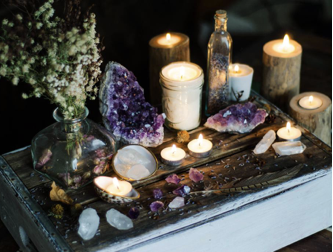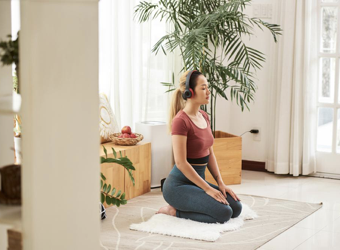Meditation has come a long way in the Western world. A decade ago, sitting quietly and clearing your mind in an effort to reach inner calm was still seen by many as a bit of an out-there idea.
Today, more than 18 million people in the United States practice meditation. And, as they say, there’s an app for that (actually, there are hundreds!). It’s no wonder more and more Americans are looking to transform part of their own homes not into a man cave or a craft room, but into a meditation space.
Now that we think about it, a miniature haven-inside-our-haven sounds like a brilliant idea. Looking to turn some of your square footage into a meditation studio of your very own? Here’s your guide to creating an at-home meditation studio.

Pick the Right Spot
We refuse to give up our Zen garden fantasies. Still, we must admit that for most of us, a room dedicated solely to meditation practice is an unlikely pipe dream. For this meditation space, we’re going to have to get creative—and that means picking a spot that can serve double-duty when we’re not trying to get in the zone.
Look to clear a space in the quietest room available to you. That could mean a few square feet in your apartment’s living area, cleaning up a bit of your walk-in closet or setting aside a corner of your home office or guest room for meditation.
If you can dedicate an entire room to meditation, you’ll want something on the smaller side. A wide-open area can become overwhelming and uncomfortable, making it difficult for you to turn your attention inward. Working with a large room in a finished basement or attic? No worries. Try using screens to create a smaller feeling room-within-a-room.
Light It Right
There’s something about natural light that makes us feel more connected to the earth and to our inner selves. However, that doesn’t mean we need direct sun to center ourselves. In fact, if you’re meditating in a room that tends to be bright when you use it to meditate, you’ll want to be able to dim that light so that you’re not fending off sudden blindness while you concentrate.
For a natural look that suits any living area, try purchasing woven bamboo shades. They provide a clean, modern aesthetic with a texture that’s warm and inviting—ideal for a meditation studio. Bonus: The wood-look is trendy right now, but the style is traditional enough to work with any interior design elements.
Get Grounded
Regardless of whether you’re used to meditating on the down-low in your desk chair or you like to settle down on the floor, the floor covering you choose is important to set the tone of your meditation space. Remember, you’re creating an area where it is easy and comfortable for you to still your energy. It’s harder to do that while perched on ice-cold concrete or slippery hardwood floors!
Pick a rug large enough to designate the boundaries of your meditation space. It could be just small enough to sit on, one you keep tucked away nearby and pull out only at the designated time. Or, it could be an area rug that remains out 24/7.
As you shop, consider your rug from a tactile point of view. Do you want something plush that you can sink into? Does your body need a little extra padding or support? Would you prefer something a little sturdier, firmer or harder to help you feel more grounded? These are all good questions to consider.

Create a Focal Point
Even if you close your eyes during your meditation, it can be helpful to construct a focal point that will help you deepen your practice, guide your personal growth and inspire you to reach new places within yourself as you meditate. In a religious sense, this would be your altar. More secularly, it’s an area you can contemplate before you move into a deeper meditative state.
What should you include? Your meditation altar should feature items that help you feel calm and centered, like candles or essential oils. It could also include religious elements, like a Buddha statue if you’re of that faith, or personal items, like family photographs. If you’re meditating with a certain goal or question in mind, keep a symbol of that intention on your altar.
Decorate Thoughtfully
As you add decorations to your meditation area, keep three Feng Shui home design principles in mind: minimalism, symmetry and balance.
Minimalism
Clutter doesn’t have a place in Eastern traditions. Meditation is no different. In fact, since your practice is focused on turning inward, you want to have as few distractions as possible. That’s exactly what clutter is: a distraction.
Each piece you add to your meditation space should serve a purpose beyond looking pretty. It should make you feel something and it should add to the overall meditative aesthetics of the space.
Symmetry
Everything from your walls to your lighting to your meditation altar should be symmetrical. Nothing should throw your eye off when you glance at it or make you feel subconsciously like your room is weighted toward one particular area or element in particular.
Balance
Meditation comes from East Asian and Southeast Asian spiritual traditions, where balance is an essential concept to consider in all areas of your life. Keeping all areas in balance is how one finds harmony—and harmony is the key to oneness.
As you add decorations to your meditation area, keep in mind the Taoist idea of the five elements: wood, metal, water, fire and earth. You’ll want to symbolize these elements in an equal way throughout your space, whether it’s on your altar, in your window coverings or through your furnishings. Consider colors, as well, since they’re also tied to these five elements.

Above all, your at-home meditation space should be a comfortable area where you can drop your guard and sink into your subconscious. While these decorative principles will help you build a space that feels meditative, only you can decide what layout and design will best allow you to discover your inner self and reach absolute calm.
Kenneth Gordon serves as the Assistant VP of Factory Direct Blinds. Kenneth is responsible for overseeing the planning, development and execution of all Factory Direct Blinds marketing and advertising initiatives. Before joining Factory Direct Blinds, Kenneth served 6 years in the United States Air Force as a Military Police Officer. Kenneth enjoys spending time with his two sons and beautiful wife Brittany when he’s not working or writing.
